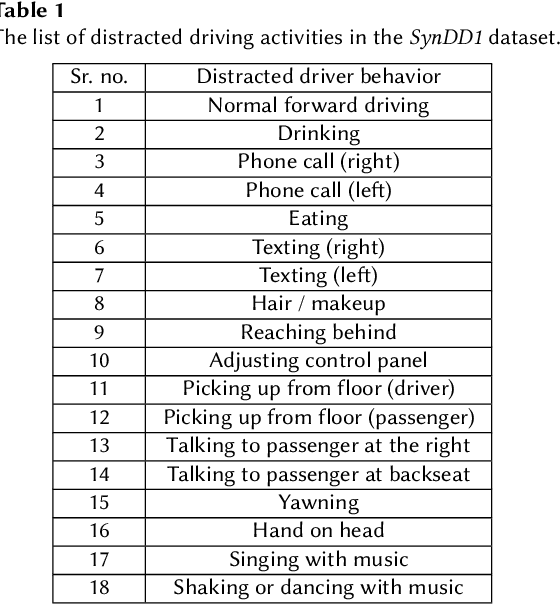Ashmit Chamoli
Towards Infusing Auxiliary Knowledge for Distracted Driver Detection
Aug 29, 2024



Abstract:Distracted driving is a leading cause of road accidents globally. Identification of distracted driving involves reliably detecting and classifying various forms of driver distraction (e.g., texting, eating, or using in-car devices) from in-vehicle camera feeds to enhance road safety. This task is challenging due to the need for robust models that can generalize to a diverse set of driver behaviors without requiring extensive annotated datasets. In this paper, we propose KiD3, a novel method for distracted driver detection (DDD) by infusing auxiliary knowledge about semantic relations between entities in a scene and the structural configuration of the driver's pose. Specifically, we construct a unified framework that integrates the scene graphs, and driver pose information with the visual cues in video frames to create a holistic representation of the driver's actions.Our results indicate that KiD3 achieves a 13.64% accuracy improvement over the vision-only baseline by incorporating such auxiliary knowledge with visual information.
Counter Turing Test ($CT^2$): Investigating AI-Generated Text Detection for Hindi -- Ranking LLMs based on Hindi AI Detectability Index ($ADI_{hi}$)
Jul 22, 2024



Abstract:The widespread adoption of large language models (LLMs) and awareness around multilingual LLMs have raised concerns regarding the potential risks and repercussions linked to the misapplication of AI-generated text, necessitating increased vigilance. While these models are primarily trained for English, their extensive training on vast datasets covering almost the entire web, equips them with capabilities to perform well in numerous other languages. AI-Generated Text Detection (AGTD) has emerged as a topic that has already received immediate attention in research, with some initial methods having been proposed, soon followed by the emergence of techniques to bypass detection. In this paper, we report our investigation on AGTD for an indic language Hindi. Our major contributions are in four folds: i) examined 26 LLMs to evaluate their proficiency in generating Hindi text, ii) introducing the AI-generated news article in Hindi ($AG_{hi}$) dataset, iii) evaluated the effectiveness of five recently proposed AGTD techniques: ConDA, J-Guard, RADAR, RAIDAR and Intrinsic Dimension Estimation for detecting AI-generated Hindi text, iv) proposed Hindi AI Detectability Index ($ADI_{hi}$) which shows a spectrum to understand the evolving landscape of eloquence of AI-generated text in Hindi. We will make the codes and datasets available to encourage further research.
 Add to Chrome
Add to Chrome Add to Firefox
Add to Firefox Add to Edge
Add to Edge